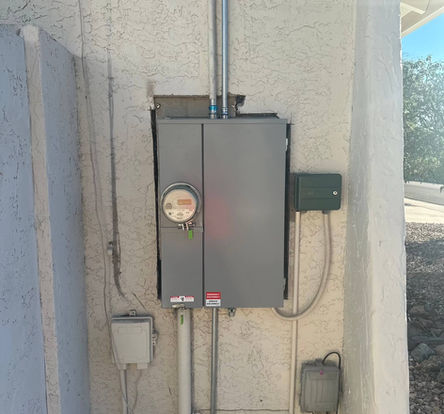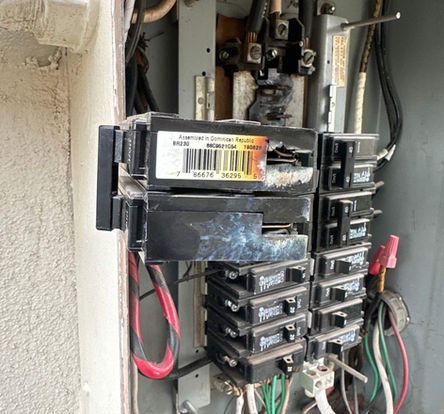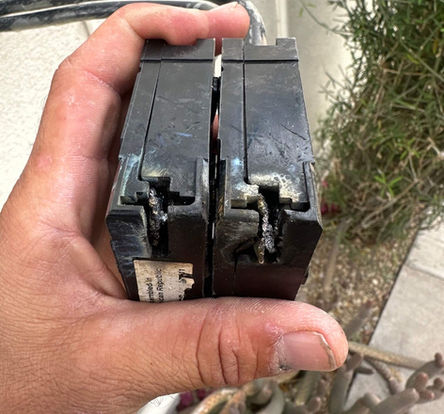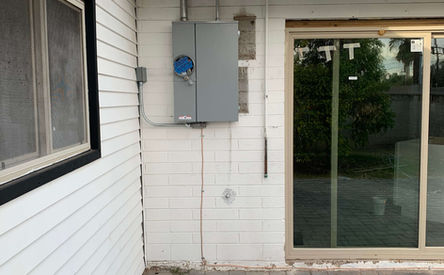
Electrical Panel Upgrade & Installation in Phoenix, AZ
Whether you need a new breaker box installed in a new build, remodel, or a panel upgrade in your current home, the electricians at JR Electrical Services are the experts you need. We're here to help make sure your family's electrical demands are easily met with the safest and most current technology available at a price that won't break the bank.
Signs You May Need An Electrical Panel Upgrade:
-
Safety Concerns - Older homes in Phoenix were built with Zinsco or Federal Pacific electric panels. These brands are known to be fire hazards. We advise upgrading these for our client's safety. Of course, if you have any parts of your panel that are burning, rotting, or have faulty components - these are safety risks as well.
-
Increased Electrical Demand - Modern households use more electrical devices and appliances than older homes were designed to handle. Upgrading your electrical panel ensures it can support the increased load.
-
Home Renovations or Additions - Any significant renovation, remodel, or addition, such as adding a new room or installing a major appliance (like central air conditioning or a hot tub), will likely require an upgrade to accommodate the extra circuits and load.
-
Electrical Code Compliance - Electrical codes are updated periodically. An older electrical panel may not meet current standards. If you're planning to sell or rent your home, upgrading your panel will be required for compliance with the latest safety regulations. Don't worry, we're fully licensed electricians, which requires us to be familiar with the City of Phoenix electrical code compliance guidelines.
-
Tripping Breakers or Blown Fuses - If the existing panel frequently trips breakers or blows fuses, it may be because the panel is overloaded or there are underlying issues that an upgrade could resolve.
-
Installation of Advanced Technology - Adding smart home systems, electric vehicle chargers, or renewable energy systems like solar panels might require an electrical panel upgrade to handle the new technology properly.
-
Insurance Requirements - Some insurance companies may require an electrical panel upgrade as a condition for coverage, especially in older homes.
-
Age of the Panel - Electrical panels generally last around 25-40 years. If the panel is approaching or has exceeded this age range, an upgrade can prevent potential failures and improve the overall safety and efficiency of the home’s electrical system.
Give our team a call or send us a message. Our experienced electricians are happy to help in your home or business!

The Difference Between 100A & 200A Electrical Panels
100-AMP
-
Capacity and Power Handling - This is usually sufficient for smaller homes with basic electrical needs. It can support standard household appliances, lights, and small HVAC systems but might struggle with more power-hungry devices.
-
Number of Circuits - Fewer slots for circuit breakers limits the number of individual circuits you can run. This can restrict the ability to add new devices or circuits without overloading the panel.
-
Room for Expansion - A 100-amp panel might not have much room for expansion. If you need to add significant new electrical equipment, you might quickly reach the panel’s capacity.
-
Suitability for Modern Homes - Older homes often have 100-amp panels, which were sufficient for the electrical demands of the past. However, with the increasing number of electrical devices and appliances in modern homes, a 100-amp panel might become inadequate.
-
Safety and Efficiency - While still safe when properly used, a 100-amp panel can become overburdened more easily, leading to potential issues like tripped breakers or overheating, which can be a safety concern.
200-AMP
-
Capacity and Power Handling - This provides significantly more capacity and is better suited for larger homes or homes with high electrical demands. It can support multiple large appliances simultaneously, such as central air conditioning systems, electric heating, hot tubs, and electric vehicle chargers.
-
Number of Circuits - More slots allows for more circuits. This means more flexibility in distributing electrical loads and the ability to add more circuits for new appliances, home additions, or renovations.
-
Room for Expansion - Whether you're planning to add new rooms, upgrade your kitchen with modern appliances, or install advanced systems like home automation, a 200-amp panel can accommodate these needs without requiring another upgrade soon.
-
Suitability for Modern Homes - Modern homes typically have higher electrical demands, making a 200-amp panel more suitable. It can handle the load of contemporary lifestyles, which include multiple large appliances, high-tech gadgets, and energy-intensive systems.
-
Safety and Efficiency - A 200-amp panel is less likely to be overburdened, which can enhance overall safety and efficiency. It can distribute electrical loads more effectively, reducing the risk of overheating and electrical fires.

Add A Surge Protector During Your Panel Upgrade
Adding a surge protector when upgrading your electrical panel is a good idea for several reasons, as it adds a layer of protection to your entire home. A few reasons homeowners may want to add a whole home surge protector are:
-
Stay compliant with current electrical codes
-
Protect against power surges
-
Improved safety
-
Prolonged lifespan for appliances
-
Cost-savings on insurance
Learn more about our whole home surge protector installation services or reach out for questions.
Why Choose Us for Your Breaker Box Upgrade?

FAMILY-OWNED & OPERATED
JR Electrical Services is a family-owned and operated, high-end electrical contractor proudly serving the metro Phoenix and surrounding areas. Our team of electricians is built on strong values with a mission to create an environment where employees and customers alike feel valued, heard, and supported—not just a number in a large company.

FULLY LICENSED & INSURED
We are fully licensed, insured, and stay up-to-date with the National Electrical Code (NEC) to ensure every installation meets the latest safety and compliance standards.

PROFESSIONAL INSTALLATION
Our experienced electricians ensure your breaker box is installed safely and efficiently, following all NFPA guidelines for fire safety and OSHA regulations. We handle all types of electrical panels from overhead to underground and can perform an inspection to see if you need a new panel or just need maintenance on your current one.

-
Do smart homes need Wi-Fi?Most smart home systems do require WiFi to setup and install, as well as to function fully with all available features. Wi-Fi enables communication between various smart devices within the home and allows users to control and monitor these devices remotely via smartphones, tablets, or computers. Some features can be accessed using Bluetooth or other bands of communication, but WiFi is the most used and widely available. Some smart devices, such as some smart light bulbs or thermostats, may function independently without WiFi connectivity, while others, like smart security cameras or voice-controlled assistants, may require WiFi to access their full range of features and capabilities, including remote monitoring and control.
-
How much Wi-Fi do you need for a smart home?The WiFi speeds needed to enable your smart home depends on several things, such as the number of devices connected to the network, the types of activities, the size of your home, and the quality of your WiFi equipment. To check your WiFi speeds or to run a WiFi speed audit, you can use sites like https://www.speedtest.net.
-
What do I need to turn my house into a smart home?All you really need is a phone to call the experts at JR Electrical Services. We take care of it all from concept to completion! You may be looking for a few more details than that though. The ingredients to a smart home are as follows: - Smart Home Hub - the hub is the brains behind the whole operation for your smart home. It’s what makes it all work together. An example of this and what we install most often for our customers is the Amazon Alexa. - Smart Devices - there are all sorts of options for smart devices, things like smart lighting, smart thermostats, smart security and doorbells, smart locks, smart plugs and outlets, smart speakers, and more. - WiFi network - most smart homes require an internet connection to communicate with you and within their own ecosystem to make things work. In our example, when you use voice-control to tell Alexa to turn on the lights, the Amazon Alexa hub uses WiFI to communicate with the smart lighting system to say, “hey you! turn on now.” Actual phrasing of the computer language may not be 100% accurate. - Mobile App or Control Interface - this can be from your phone, computer, or tablet. Most smart home systems have their own apps you can download and configure to your own custom settings.
-
What happens to my smart home when the internet goes out?Depending on your smart home hub, a few things could happen, loss of remote control and limited functionality are the most common things to happen when your internet goes out in a smart home. Some smart home’s allow you to retain local control options, meaning as long as you’re at home and within the four walls of your home, you’ll still be able to turn things on and off. The same goes for automations and routines, they’ll still work locally, but you just can’t make any changes to them. So, if you have your lights setup to turn on at sunset, they’ll still turn on. But if you wanted to change that while the internet was out, you’ll have to wait. Sending and receiving security alerts may not work, but alarm sirens should still function. Lastly, voice-control may not work when the internet is out.
-
Do you need special wiring for a smart home?This is one of those questions where the answer is going to depend on several factors. The age of your home and your smart home needs being the two biggest factors. In any case, we'll perform a complete assessment before we begin and will address any panel upgrades or new outlets that may need to be installed, along with your smart home upgrade. Here are a few other things to consider: Power Requirements: Many smart devices, like smart bulbs, switches, plugs, and sensors, work with standard electrical outlets. They don’t typically require special wiring beyond what is already built into most homes in Phoenix. Low-Voltage Wiring: Some smart home devices, like those made for security and automation systems, might require low-voltage wiring for power and communication, for example, security cameras, doorbell cameras, and smart thermostats. Low-voltage wiring can often be installed without significant modifications to existing electrical systems and is commonly used for home security and automation purposes. Ethernet Wiring: While Wi-Fi is the most common method of connecting smart devices in a home, some users prefer to use Ethernet wiring for certain applications, especially for devices that require high-speed and reliable connections, such as streaming media players, gaming consoles, or home office equipment. Ethernet wiring typically involves running Cat5e, Cat6, or Cat6a cables from a central networking location (e.g., router or switch) to individual devices or access points throughout the home. Structured Wiring Systems: In new construction or major renovations, homeowners might opt to install structured wiring systems that provide centralized distribution of various types of cables, including Ethernet, coaxial, and even telephone cables, to different rooms and locations within the home. Structured wiring systems can are a great idea to ensure scalability of any future technology needs and facilitate the integration of smart home devices and systems.






















